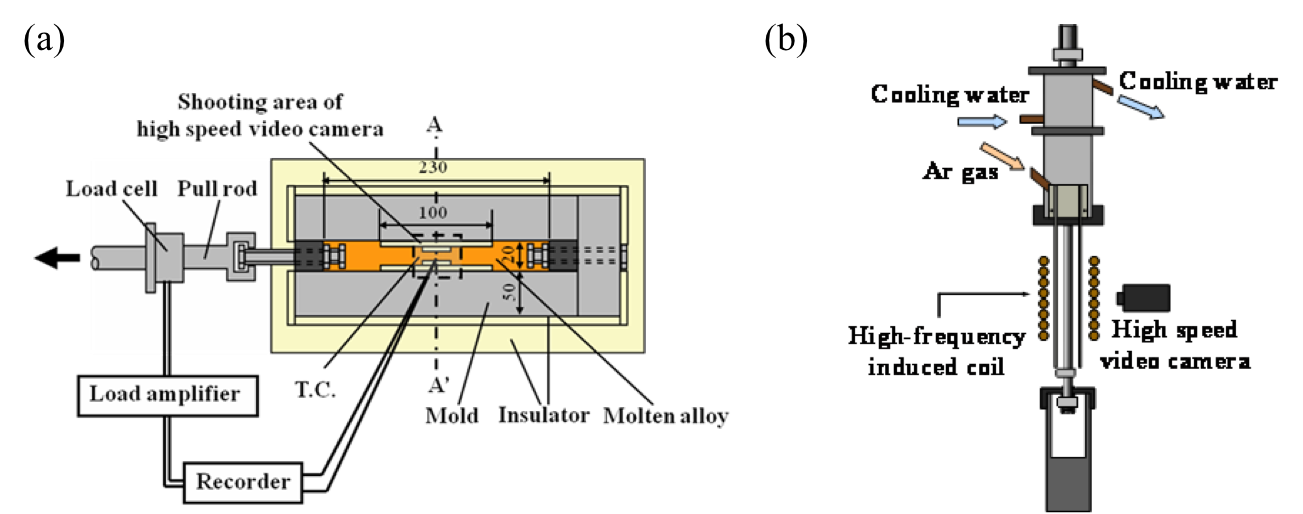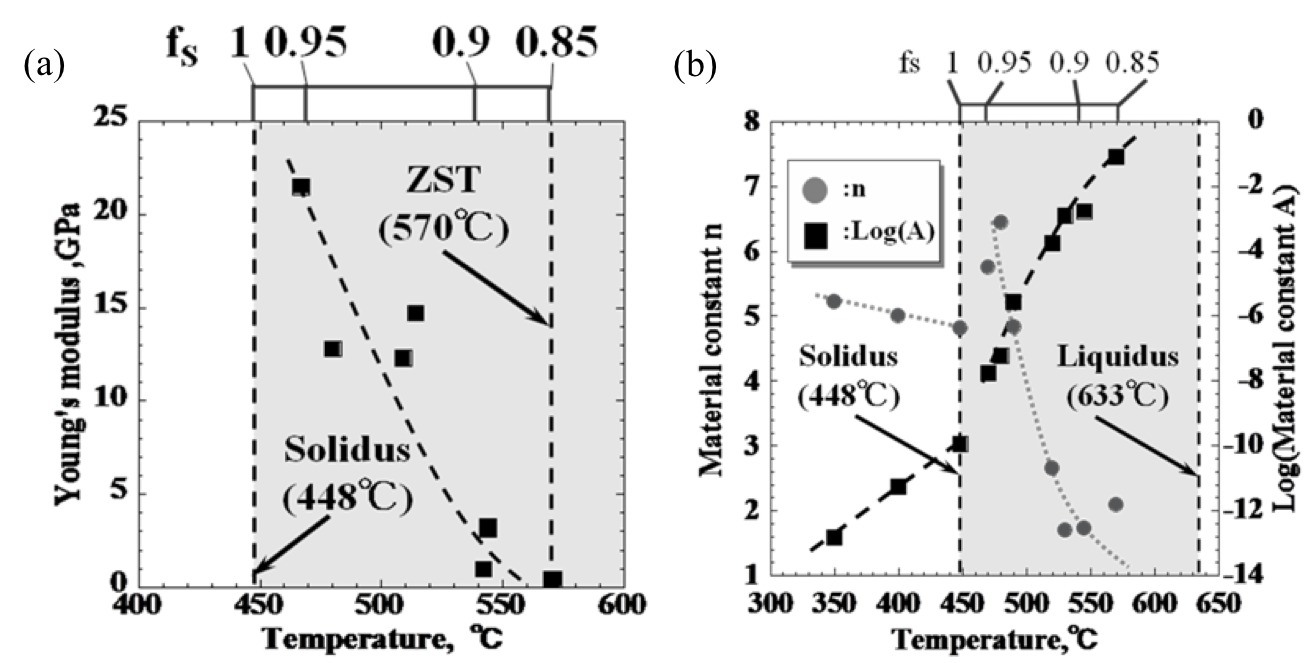Aluminium Alloy Casting Defect Prediction
Introduction
As the mechanical properties for materials used for automobile parts are improving, the application of non-eutectic wrought aluminium alloys (e.g. Al-Cu, Al Mg, Al-Zn-Mg-Cu type), which are never being used as casting materials are highly anticipated to be applied into casting (Fig.1(a)). Although such alloys are superior in mechanical properties at room temperature as compared with conventional casting alloys (e.g. Al-Si type), castability is poor and defects such as solidification cracking are generated, which hinder the application of such alloys in this low cost processing method, i.e. casting. On the other hand, in direct chill (DC) casting, the problem of solidification cracking has already garnered attention as can be seen in Fig. 1(b). In a literature review conducted by our group, the theory of solidification crack and its estimation method have been reported globally, mainly in North America and Europe, and it is one of the areas that has attracted attention in casting research field.
In our laboratory, we study the phenomena of solidification cracking from the viewpoints of as follows: (1) the mechanical properties of solid-liquid coexistence state, (2) solidification crack prediction by FEM thermal stress analysis, and (3) solidification crack detection by Acoustic Emission (AE) method. Solidification cracking occurs in a state where solids and liquid coexist like a sherbet (hereinafter referred to as solid-liquid coexisting state), so the mechanical properties of solid-liquid coexistence state for stress analysis are indispensable. It is extremely difficult to acquire this experimentally and the attempt to develop material test apparatuses in solid-liquid coexistence state have been conducted worldwide.
Our laboratory systematically investigated the conventional solid-liquid coexisting state tensile testing equipment, reviewed its features and problems, and developed a tensile testing machine that solves those problems. Here, we report about the solid-liquid coexistence state (hereinafter referred to as semi-solid state) and elastic-creep properties below the solidus temperature during cooling process that was acquired using the test equipment that was developed in our laboratory.

Experimental
The test material used in this study was Al-Mg alloy (JIS AC7A). This alloy is a non-heat treatment type, but has a moderate strength at normal temperature and excellent ductility, so that it is suitable material for car body material parts. However, due to its poor castability such as solidification cracking, the application into casting is hindered.
Unloading test was conducted at temperature higher than solidus temperature using a semi-solidification tensile testing apparatus as shown in Fig. 2(a), which was developed by our laboratory. The reversibility of the strain was confirmed, and elastic properties in the semi-solidified state was acquired (see Result 1). In addition, by using high frequency induction heating type tensile test machine that was also developed by our laboratory (Fig. 2(b)), tensile test in a semi-solidified state, and also below the solidus temperature with varied tensile speeds was conducted. From the relationship between the maximum stress and the strain rate at that time, creep properties were acquired (see Result 2).

Results
Results 1: Elastic properties of semi-solidified state
Fig. 3(a) shows the temperature-dependence of the longitudinal modulus of elasticity obtained by unloading test using semi-solid tensile testing equipment. From the result, it is clear that the elastic modulus in the semi-solidified state was asymptotic to 0 at around 570 ℃. Although it is unknown whether this mechanism of elastic behavior is the same as that of the solid state, it can be suggested that the solid phase shows elastic behavior even in the semi-solidified state.
Results 2: Creep properties
The following power law was established for the relationship between the creep strain rate and the maximum stress acquired by each test equipment. The calculated creep properties i.e. common logarithm of stress index, n, and material constant, A [(MPans)-1] are shown in Fig. 3(b). Scheil-Gulliver model was used for the relationship between solid fraction and temperature.
dεcreep/dt = Aσn
As shown in Fig. 3 (b), each creep property demonstrates discontinuous behavior with the solidus temperature as the boundary. In particular, with respect to the stress index n, the change was noticeable in the semi-solidified state as compared with the solidus temperature or lower.

Conclusion
We attempted to acquire the elasticity and creep properties of Al-Mg based alloy from semi-solidified state to solid state, and applied to Hooke's law and power law. The findings are described as follows.
- The longitudinal modulus of elasticity in the semi-solidified state was 22GPa in the vicinity of the solidus line and asymptotic to 0 at around 570°C.
- The creep properties were discontinuous with the solidus temperature as the boundary.
- When the temperature is higher than the solidus temperature, the strain rate dependence greatly varies with temperature.
Currently, the validity of the constitutive equation is evaluated by comparing the deformation behavior occurring in the simple shape casting with the thermal stress analysis. We also investigate the influence of crystal grain size and casting riser, which are the factors affecting solidification cracking on the mechanical properties of semi-solidified state, and the mechanical properties of semi-solidified state of other alloys.
Publications
- Rei Hirohara, Yasutaka Kawada, Ryosuke Takai, Mitsuhiro Otaki, Toshimitsu Okane, Makoto Yoshida, Prediction and experimental validation of cooling rate dependence of viscoplastic properties in a partially solidified state of Al-5 mass%Mg Alloy, Materials Transactions 58 (2017) 1299-1307
- R. Takai, S. Kimura, R. Kashiuchi, H. Kotaki, M. Yoshida, Grain refinement effects on the strain rate sensitivity and grain boundary sliding in partially solidified Al-5 wt%Mg alloy, Materials Science and Engineering A 667 (2016) 417-425
- Ryosuke Takai, Akira Matsushita, Shogo Yanagida, Koichiro Nakamura, Makoto Yoshida, Development of an elasto-viscoplastic constitutive equation for an al-mg alloy undergoing a tensile test during partial solidification, Materials Transactions 56 (2015) 1233-1241
- Ryosuke Takai, Akira Matsushita, Shogo Yanagida, Koichiro Nakamura, Makoto Yoshida, Development of elasto-viscoplastic constitutive equation for Al-Mg alloy with tensile test in partial solidification, Journal of Japan Institute of Light Metals 63 (2013) 310-317
Below are some videos showing some preview on the experiments and several types of simulation conducted by this group.
-
Semi-solidified tensile test (Ohya-Method)
-
Heat-resistant magnesium die-cast cracking simulation
-
Semi-solidified tensile test at 468 °C showing brittle fracture
-
Semi-solidified tensile test showing healing of test specimen
-
I-beam flow casting simulation showing stress field (ProCAST)
-
I-beam casting experiment
-
I-beam flow casting simulation showing temperature field (ProCAST)
-
Thermo-mechanical simulation of DC slab (semi-continuous casting)
